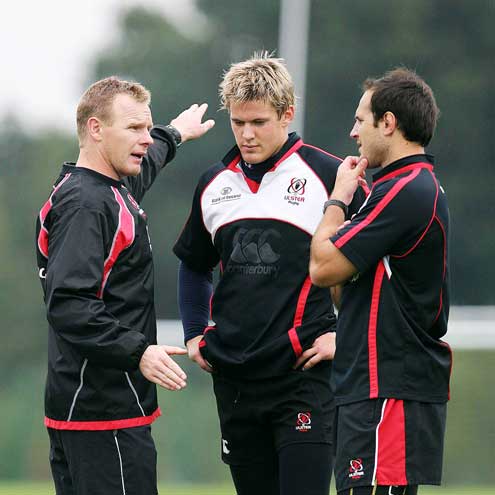Complaints are expressions of "displeasure or annoyance" in response to an action that is seen by the speaker as unfavorable. Here's one of complaining dialogue:
| Mr Ryefield: | — Waiter! | |
| Waiter: | — Is everything all right, sir? | |
| Mr Ryefield: | — Not exactly. This steak is raw. I asked for it well done! And it´s rather cold. | |
| Waiter: | — I do apologise, sir. Would you like it cooked a little more? | |
| Mr Ryefield: | — Please. | |
| Waiter: | — Would you like something else while you´re waiting? | |
| Mr Ryefield: | — No, thank you. But tell them to hurry. |
Making a Complaint:
Here are useful expressions you can use when complaining:
Excuse me, there seems to be something wrong with…
Excuse me, there appears to be something wrong…
I wonder if you could help me…..
Responding to complaints
Accepting a Complaint:
Oh, I’m sorry about that.
I can’t tell you how sorry I am
I wish it never happened
Delaying a Complaint
I suggest you leave it with us and we’ll see what can be done.
I suggest you leave it with us and we’ll see what we can do.
I’m afraid the manager/boss isn't in at the moment. Could you call later?
Rejecting a Complaint
Sorry there is nothing we can do about it.
I'm afraid, there isn't much we can do about it.
We are sorry but the food is just alright.
Giving instruction is an expression that is used in order that order that other person does what we instruct or request, or giving imperative to other people for to do or not to do something, Giving instruction sometimes called comparative/prohibition. The tense used in giving instruction is simple present.
There are two parts to giving instructions. What we call Sequencers and then the actions.
sequencers are the words that help order your instructions. It is like the 1, 2, 3, 4 of your actions.
The most common are First(ly), ...Then, ...Next, ...After that, ...Finally, ...
The most common are First(ly), ...Then, ...Next, ...After that, ...Finally, ...
> Sequencing
Before you begin, (you should . . .)
The first thing you do is . . . .
I would start by . . .
The best place to begin is . . .
To begin with,
> Starting out
After that,
The next step is to . . .
The next thing you do is . . .
Once you've done that, then . . .
When you finish that, then . . .
> Continuing
The last step is . . .
The last thing you do is . . .
In the end,
When you've finished,
When you've completed all the steps
> Finishing
Instructions
do one of three things.
1) Tell people what is necessary.
2) what is wrong.
3) what is not necessary.
1) Tell people what is necessary.
2) what is wrong.
3) what is not necessary.
Here is an example. . .
How to use a public telephone
First make sure you have coins before you use the phone.
Lift the receiver and wait for the dial tone (if you don't hear it, it means phone is not working. Say goodbye to that one and try another. Then you will see the instructions in the display that ask you to put a coin in the coin slot.
As soon as you put the coin in the coin slot, you will see 'Dial the number; in the display.
Dial the number you want to call. If you exceed 60 seconds, you will have to useone more coin before the countdown clicks 0 in the display; or the call will be disconnected.
Once you are done with the call,keep put the receiver (the thing you hold to your mouth and ear) in the cradle.
If you are lucky or the owner of the phone/phone dept. is unlucky, sometimesit happens when you put hang up the receiver down in the cradle, you may get your coin back in the coin outlet, despite you having made a call. This That is because of the due to a mechanical fault in the internal things of the phone.
If you are unlucky (!),again sometimes it happens the phone would swallow(eat) your coins without letting you to make any calls. Meaning means you neither can't make calls or you get your coin back.
In case Ifthe number you are calling is not reachable or busy or whatever, you have to hang up put the receiver down and take the coin back from the coin outlet and follow the above procedure again, in order to try again.
Lift the receiver and wait for the dial tone (if you don't hear it, it means phone is not working. Say goodbye to that one and try another. Then you will see the instructions in the display that ask you to put a coin in the coin slot.
As soon as you put the coin in the coin slot, you will see 'Dial the number; in the display.
Dial the number you want to call. If you exceed 60 seconds, you will have to use
Once you are done with the call,
If you are lucky or the owner of the phone/phone dept. is unlucky, sometimes
If you are unlucky (!),
1) Use verb as commanding word in the form of infinitive without to : Examples :
Examples :
Examples :
- Sit down.
- Sweep the floor.
- Clean the whiteboard.
Examples :
- Be careful !
- Be quite!
- Be on time !
Examples :
- Don’t climb!
- Don’t do it !
- Don’t let them in…
- Please, wake up. / Wake up, please.
- Please, be quite. / Be quite, please.
- Please, do your homework. / Do your homework. Please.



0 comments:
Post a Comment